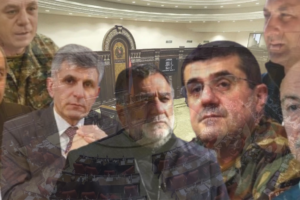Formula 1 drivers say that the racing in Azerbaijan was compromised by the decision to cut the DRS zone on the main straight by 100 metres compared to last year.
Both the sprint and the main event in Baku were notable for a lack of passing compared to previous events at the track, with Mercedes boss Toto Wolff labelling it “boring”.
The FIA has the right to adjust the activation point of DRS zones, usually based on data gathered at the last event at the venue and at previous races during the current season.
Drivers already highlighted their concerns about the 100-metre cut in Baku in their Friday briefing with race director Niels Wittich, but no change was made, and nor was it addressed for the grand prix after the sprint featured a lack of overtaking.
Lewis Hamilton, who was heard asking his team for more power at one point in Sunday’s race as he chased Carlos Sainz, was one of the many drivers who felt the DRS zone wasn’t long enough.
“Nothing went wrong but I just wanted more power,” said Hamilton. “A driver always wants more power.
“And I think ultimately they shortened the DRS this year down the straight, I don’t quite know why they did that. We’ve always had great racing where the DRS was.
“By the time you switched the DRS on, it was too late. Was there a lot of overtaking today? Well, there you go.”
Alex Albon was another who felt that the start of the activation point should have stayed where it was in 2022.
“You saw it, there wasn’t much overtaking, the DRS was too short,” said the Williams driver. “I think they showed that last year, it wasn’t in a bad place, and they took 100 off it. You could maybe go another 100.
“The drivers did speak about this in the drivers’ briefing on Friday. These cars, as the load is coming onto the cars, they’re getting harder to follow now, not as good as it was before.
“And then the slipstream hasn’t been as good as previous year’s cars. That’s why you’re seeing this DRS train.”

Lando Norris, who spent much of the race stuck behind late-stoppers Esteban Ocon and Nico Hulkenberg and couldn’t take advantage of his fresher tyres, was another who felt frustrated by the shorter DRS zone.
“It’s pretty much impossible to overtake especially with our straightline speed,” he said.
“Not with how short the DRS zone is now compared to where it was last year. I did the best I could to try and keep up with the cars ahead. I just used the tyres up too much, because we’re not on the same level.”
Asked if a shorter DRS zone made sense, he added: “No, none. All the drivers questioned it in the drivers’ briefing.”
Norris’s McLaren boss Andrea Stella agreed that the zone could have been longer while acknowledging the bigger picture of a reduced slipstream effect that was highlighted by Albon.
“It definitely took a little bit of the edge off you in braking,” said the Italian.
“If you are like 5-10 metres closer, you can try and attack, which like for us today was impossible during the whole race. So certainly for us, it would have been welcomed.
“I think what the FIA and F1 have to look at carefully is this year it looks like it was generally more difficult to overtake, possibly not only because of DRS, but because of a little less slipstream effect.
“The suction effect following the car ahead seems to be a little less than normal, but this may depend on various factors.”
While agreeing that his own drivers found it hard to overtake Alpine sporting director Alan Permane defended the FIA decision to trim the Baku zone.
“You have to be very careful when you’re talking about things like that and who you’re asking,” he said.
“Because if you’re in the front, you don’t want any DRS zones. And if you’ve got a quicker race car than a qualifying car, you want longer DRS zones.
“So I think those things are best left to the FIA to judge on their data. And that’s of course what happens.
“They have a performance department, they look at things. I think they look back at last year and felt overtaking was a little bit easy. And that’s why they shortened it.”
Source : Motorsport.com





